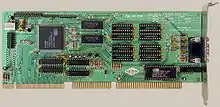Super VGA
Super VGA (SVGA) is a broad term that covers a wide range of computer display standards that extended IBM's VGA specification.[1]
 Typical VLB SVGA card | |
| Release date | August 31, 1987 |
|---|---|
| History | |
| Predecessor | Video Graphics Array |
| Successor | XGA |
When used as shorthand for a resolution, as VGA and XGA often are, SVGA refers to a resolution of 800 × 600.[2]
History

In the late 1980s, after the release of IBM's VGA, third-party manufacturers began making graphics cards based on its specifications with extended capabilities. As these cards grew in popularity they began to be referred to as "Super VGA."
This term was not an official standard, but a shorthand for enhanced VGA cards which had become common by 1988.[1] The first cards that explicitly used the term were Genoa Systems's SuperVGA and SuperVGA HiRes in 1987.[3]
Super VGA cards broke compatibility with the IBM VGA standard, requiring software developers to provide specific display drivers and implementations for each card their software could operate on. Initially, the heavy restrictions this placed on software developers slowed the uptake of Super VGA cards, which motivated VESA to produce a unifying standard, the VESA BIOS Extensions (VBE), first introduced in 1989,[4] to provide a common software interface to all cards implementing the VBE specification.[5]
Eventually, Super VGA graphics adapters supported innumerable modes.
Specifications
The Super VGA standardized the following resolutions:[4]
- 640 × 400 or 640 × 480 with 256 colors
- 800 × 600 with 24-bit color depth
- 1024 × 768 with 24-bit color depth
- 1280 × 1024 with 24-bit color depth
SVGA uses the same DE-15 VGA connector as the original standard, and otherwise operates over the same cabling and interfaces as VGA.
Early manufacturers
Some early Super VGA manufacturers and some of their models, where available:
- Ahead Technologies (Not related to Nero AG, formerly Ahead Software)
- Amdek: VGA ADAPTER/132 (Tseng Labs chipset)[6]
- AST Research, Inc.: VGA Plus[7] (rebranded Paradise)
- ATI Technologies: VIP (82C451),[8] VGA Wonder
- Chips and Technologies: 82C451[8]
- Cirrus Logic: CL-GD410/420[9]
- Compaq: VGC Board (Paradise chipset)
- Everex
- Genoa Systems: Genoa VGA 5100-5400[10] (ET3000)[11]
- Orchid Technology: Designer VGA[12] (ET3000), Pro Designer Plus
- Western Digital's Paradise Inc.: VGA Plus[13] (PVGA1), VGA Plus 16, VGA Pro
- Sigma Designs: SigmaVGA (ET3000)
- STB Systems: VGA Extra/EM (ET3000),[14][15] V-RAM VGA[16]
- Willow Peripherals: VGA-TV/Publisher's, VGA-TV + Genlock[17]
- Trident Microsystems: TVGA8800, TVGA8900, and TVGA9000 series
Gallery
 ALiCat M3147V SVGA video card
ALiCat M3147V SVGA video card Cirrus Logic GD5429 VLB SVGA video card
Cirrus Logic GD5429 VLB SVGA video card Early 1996 IGS IGA1682_A PCI SVGA video card
Early 1996 IGS IGA1682_A PCI SVGA video card S3 805 VLB SVGA video card
S3 805 VLB SVGA video card WDC ISA SVGA video card
WDC ISA SVGA video card
References
- Richter, Jake (1990-07-16). "High-Resolution Video Boards". InfoWorld. InfoWorld Media Group, Inc. 12 (29): 55. ISSN 0199-6649.
- "Projector Guide - Resolution | Epson US". epson.com. Retrieved 2020-08-17.
- Gabel, David (December 1, 1987). "Plug-compatible vendors take aim at VGA card". PC Week. Ziff-Davis. 4 (48): 148 – via Gale.
- "SUPER VGA BIOS EXTENSION Standard # VS891001 › Gemixtes". 2013-12-11. Archived from the original on 2013-12-11. Retrieved 2022-12-27.
- VESA BIOS Extension (VBE) Core Functions Standard 3.0 (PDF). Milpitas, CA: Video Electronics Standards Association. 16 September 1998. p. 3.
- Juris, Robbin; Miller, Catherine; Ricciardi, Salvatore; Tate-Austin, Priscilla (1988-11-15). "Small-Footprint 386 PCs". PC Mag. Ziff Davis, Inc. 7 (2): 98. ISSN 0888-8507.
- stason.org, Stas Bekman: stas (at). "AST VGA PLUS (202262-001, 002, 003) video card Settings and Configuration". stason.org. Retrieved 2022-12-27.
- Unknown ATI 8-bit videocard, Google Groups
- Need info on old Video Seven VGA card, Google Groups
- stason.org, Stas Bekman: stas (at). "SUPERVGA HIRES-10 5200-10, SUPERVGA 5100 video card Settings and Configuration". stason.org. Retrieved 2022-12-27.
- "Motherboards/Laptops built-in graphics".
- stason.org, Stas Bekman: stas (at). "DESIGNER VGA video card Settings and Configuration". stason.org. Retrieved 2022-12-27.
- stason.org, Stas Bekman: stas (at). "PARADISE VGA PLUS 16 video card Settings and Configuration". stason.org. Retrieved 2022-12-27.
- VGA, or what to do with my tax return!, Google Groups
- VGA monitor and adapter choices, Google Groups
- IBM's EGA and VGA, Google Groups
- Poor, Alfred (July 1989). "VGA and NTSC: Putting your Program on TV". PC Mag. Ziff Davis, Inc. 8 (13): 158. ISSN 0888-8507.